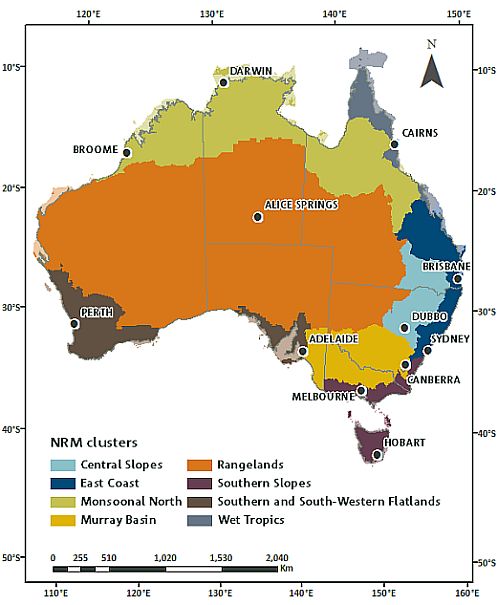Climate Change in Australia
Climate information, projections, tools and data
NRM Regions

Map showing the eight clusters of Australia used for the climate change projections
The climate change projections presented on this site and discussed in the various associated reports are presented using a unique Australian regionalisation scheme.
The scheme has three levels of regional detail that align with the primary goal of supporting the Australian natural resource management sector.
The scheme, developed in consultation with the Department of the Environment, defines eight natural resource management (NRM) clusters. This was informed by logical groupings of recent past climatic conditions, biophysical factors and expected broad patterns of climate change. Where possible, the cluster boundaries were aligned with existing boundaries of regional NRM organisations (as at January 2013). The clusters are shown to the right. There is a Cluster Brochure and a Cluster Report describing climate change projections for each cluster.
Further sub-division of these Clusters was needed in some cases to better capture the important patterns of projected change. In light of this, five of the eight clusters were further sub-divided, creating 15 sub-clusters. Descriptions of projected change at the sub-cluster level can be found within the Regional Climate Change Explorer .
The NRM clusters are also amalgamated into four Super-clusters: Northern Australia, Eastern Australia, Southern Australia and Rangelands. This regionalisation is used to report climate changes at a broader scale while permitting representation of differing projected climate changes for the major climatic zones. Key messages at the super-cluster scale can be found on the Regional Climate Change Explorer .
More information on the regionalisation schemes, and their relationship to Australia’s NRM organisation boundaries can be found in Chapter 2 of the Technical Report .
Cluster search tool
Download the excel spreadsheet below to find out which cluster you are in.
CCIA NRM Location search tool (172.0 KB)
Regionalisation scheme maps
Regionalisation scheme shape files
![]() NRM Super-cluster shapefile (2.5 MB)
NRM Super-cluster shapefile (2.5 MB)
![]() NRM Cluster shapefile (3.7 MB)
NRM Cluster shapefile (3.7 MB)
![]() NRM Sub-cluster shapefile (4.1 MB)
NRM Sub-cluster shapefile (4.1 MB)
Page updated: 28th June 2019



